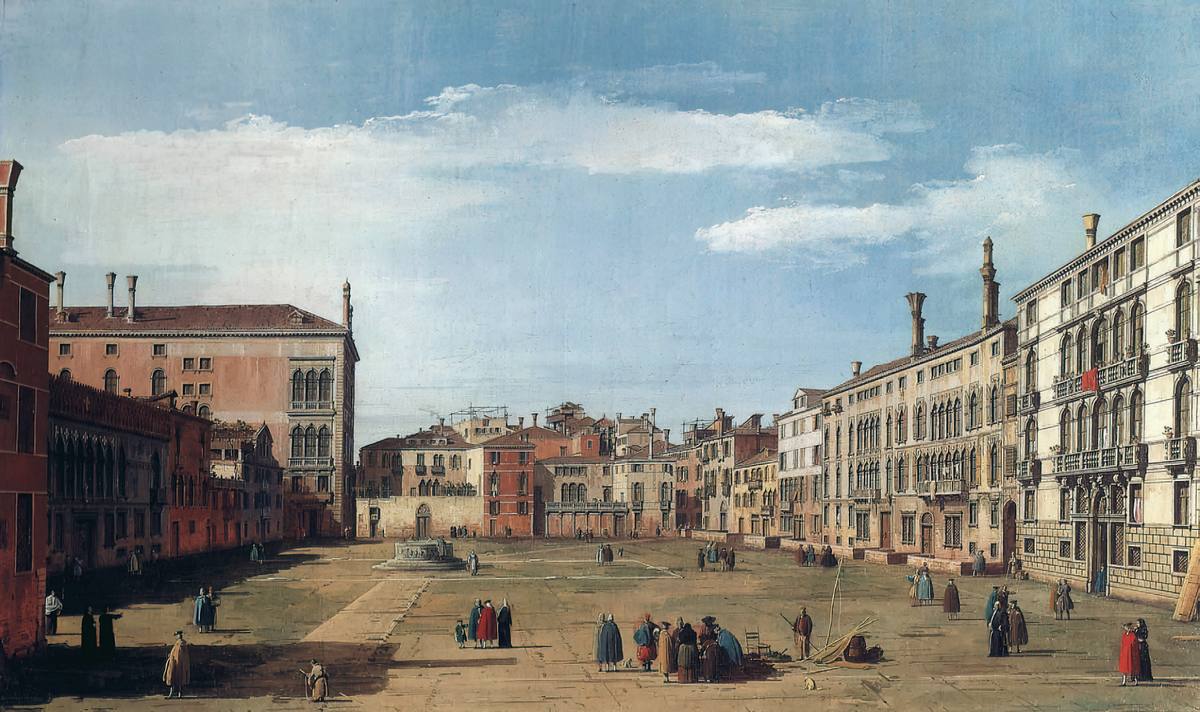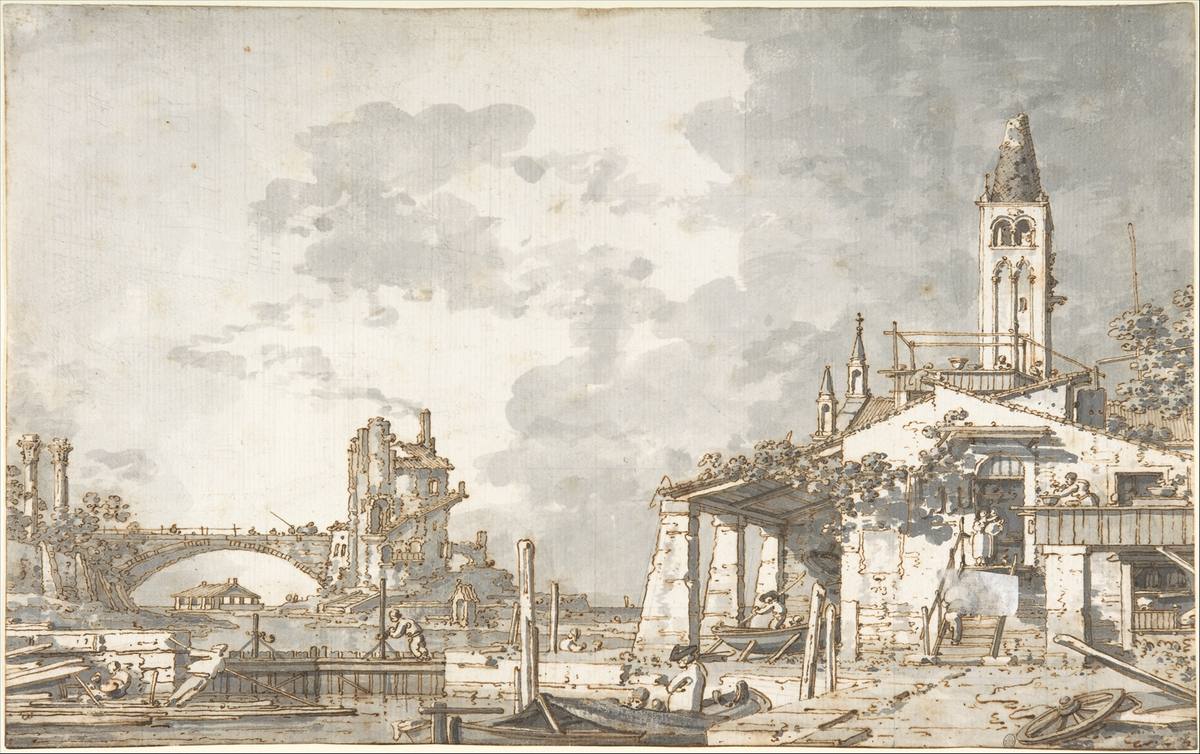
Business as usual
Canaletto the Artisan Painter
There is a remark I've read on the book "The Kraken Wakes" by John Wyndham* and published in July 1953 that explains my point here:
"As for ... Art, really only became Art in the last two centuries. Essentially, before that, it was furniture for improving one's home."
XVIII century painters saw themselves as "artisans", and they were, really, Art is a modern concept, that makes the output and skills of these artisans become "invested money" for who has plenty of it.
Just and example: the Canaletto painting "The Bucintoro at The Molo, Venice, On Ascension Day", for instance, sold for $20 million in a Christie's London Auction on July 6th, 2005.
It is a 150x137 cm painting, quite big for our home settings nowadays, but nevertheless, that was sort of the standard size for Canaletto and other painters of the time.
Nowadays these artisans-of-the-past works end up in Museums where viewers can see the real thing, or ... on the web, in the www.antoniocanal.com website for instance.
The Canaletto Workshop
Maturity and a good business running could give also a certain psycological stability to any artist, and Canaletto was reaching his own.
But this situation always asks, at the same time, for productivity.
Canaletto was for sure quite fast with pens and brushes, but he would stay behind in his deliveries, as he wanted to always deliver a perfect painting.
This brings a question: did he have assistants to help him with the process?
He surely did, as this was a common practice in those times. But there is no documentation about whom and how many could have been his assistants, the people working in his bottega (workshop).
And sometimes we may find paintings defined as "Canaletto workshop", meaning they came from his bottega, but don't have the master's touch, the one that really may make the difference.
Bernardo Bellotto goes in there for sure, as Canaletto very likely passed his art secrets to his nephew since a very early age.
We know that Bernardo Bellotto had 15 of his paintings sent by Anton Maria Zanetti di Girolamo to the Castle Howard, in Yorkshire in 1739. Bellotto was, at this time, 17 years old.
Also in 1740 again A.M. Zanetti the elder organizes the fist travel outside Venice for Bernardo Bellotto , where he can make some paintings that he will sign as "Canaletto".
And on November 5, 1741 the young Bellotto, close to getting married, states that he can support his future family with his work: nineteen years old he was.
Talking about new generation coming to create their own recognition ...
* John Wyndham (1903-69) was the English science fiction writer author of "The Day of the Triffids (1951)" from which it was made this tense but ingenuous movie in 1962. Worth reading and watching, meet the "killer ivy" and stuff like that.
![Canaletto: [1730s] - Campo Santa Maria Zobenigo - Oil on canvas - Metropolitan Museum of Art, New York](../images_db/Canaletto_1730s__p097_Campo_Santa_Maria_Zobenigo_500289ld.jpg)

![[2005] - Christies auction - Venice Bacino di San Marco on Ascension Day - $20 million](../images_db/Christies-auction-2005--x044-Venice-Bacino-di-San-Marco-on-Ascension-Day-g7xm9r-gp1a.jpg)
![Canaletto: [1754] - Venice - Bacino di San Marco on Ascension Day - Oil on canvas - Private Collection](../images_db/Canaletto_1754__p208_CR_256_Venice_Bacino_di_San_Marco_on_Ascension_Day--gp1c.jpg)
![Canaletto: [August 2, 1725] - Receipt for a 10 Sequins down payment from Stefano Conti for two paintings, on an estimate ot 20 Sequins each, and will accept 20-25 Sequins as a final balance](../images_db/Canaletto--x025-August-2-1725-receipt-1-gp2a.jpg)
![Canaletto: [November 25, 1725] - Receipt for 2 paintings he has made, and for which he has received from Stefano Conti 30 Sequins each as a down payment. But since the price he estimates is 22 Sequins each, Canaletto will keep the difference as a down payment for the other for two paintings - same size and same price - that have been requested and he will deliver](../images_db/Canaletto--x026-November-25-1725-receipt-2-gp2a.jpg)
![Canaletto: [December 22, 1725] - Receipt for a 10 Sequins down payment from Stefano Conti for two paintings he will deliver](../images_db/Canaletto--x027-December-22-1725-receipt-3-gp2a.jpg)
![Canaletto: [June 15, 1726] - Receipt for a present he receives of 10 Sequins, in addition to the other 80 Sequins payment Stefano Conti has made for four paintings](../images_db/Canaletto--x028-June-15-1726-receipt-4-gp2a.jpg)
![Canaletto: [June 18, 1726] - Receipt declaring he has made 2 paintings for Stefano Conti, same size as those of the previous year, and providing a detailed description of what is in the paintings](../images_db/Canaletto--x029-June-18-1726-receipt-5-gp2a.jpg)
![[1748] - Receipt made by Canaletto for a 10 Guineas payment he received from Lord Bruk regarding a small painting he sold him in London](../images_db/London-1748--x005-CR1886_Box490_Bundle10_Voucher1747-Canaletto-11a.jpg)

![Canaletto: [ca. 1735] - Veduta Ideata with San Simone Piccolo - Drawing - Pen and brown ink with gray wash over traces of black chalk on yellow antique laid paper - Detroit Institute of Arts](../images_db/Canaletto_1735ca__d203_Veduta-Ideata-with-San-Simone-Piccolo-DIA--29.171-d1.jpg)
![Canaletto: [1728-32] - The Grand Canal near the Rialto Bridge - Oil on canvas - Museum of Fine Arts, Houston, TX - Courtesy: Google Art Project](../images_db/Canaletto_1728-32__p109_The_Grand_Canal_near_the_Rialto_Bridge,_Venice_Google_Art_Project_1.jpg)
![Canaletto: [1738] - Il Canal Grande dalla chiesa di Santa Maria di Nazareth - Oil on canvas - Pinacoteca Giovanni e Marella Agnelli, Torino](../images_db/Canaletto_1738__p187_CR_170b_Il_Canal_Grande_dalla_Chiesa_di_Santa_Maria-gp1.jpg)
![Canaletto: [mid 1730s] - View of the Piazzetta with the Southwest corner of th Doge Palace - Oil on canvas - Private Collection](../images_db/Canaletto_1730smid__p089_View_of_the_Piazetta_with_the_Southwest_corner_of_the_Doge_Palace-gp.jpg)
![Canaletto: [mid 1730s] - San Zaccaria (View of San Zaccaria) - Oil on canvas - Private Collection](../images_db/Canaletto_1730mid__p072_San_Zaccaria-1.jpg)
![Canaletto: [ca. 1735] - Venice - a view of the Piazzetta looking North - Oil on canvas](../images_db/Canaletto_1735ca__p177_Venice-a-view-of-the-Piazzetta-looking-North-516667ld.jpg)
![Canaletto: [ca. 1735-40] - Venice - Campo San Francesco della Vigna - Drawing - Pen and ink, over free and ruled pencil and pinpointing - Royal Collection Trust, RCIN 907494](../images_db/Canaletto_1735-40ca__d050_Venice--Campo-San-Francesco-della-Vigna--RCIN-907494.jpg)
![Canaletto: [1724-30] - The Riva degli Schiavoni - Oil on canvas - Kunsthistorisches Museum, Vienna](../images_db/Canaletto_1724-30__p022_The_Riva_degli_Schiavoni_WGA03889_a1.jpg)
![Canaletto: [mid 1730s] - Grand Canal looking East from Palazzo Bembo to Palazzo Vendramin Calergi - Oil on canvas - Private Collection, Woburn Abbey](../images_db/Canaletto_1730mid__p168_CR_097_grand-canal-looking-east-from-palazzo-bembo-to-palazzo-vendramin-calergi-1367vv_sml-gp.jpg)

![Canaletto: [1735-39] - The Riva degli Schiavoni - Oil on canvas - Toledo Museum of Art - Courtesy: Google Art Project](../images_db/Canaletto_1735-39__p107_the_Riva_degli_Schiavoni__Goog.jpg)
![Canaletto: [ca. 1738-39] - The Campo Santi Giovanni e Paolo, Venice, with the West End of the Church and the Scuola di San Marco - Oil on canvas - Private Collection](../images_db/Canaletto_1738-39ca__p169_CR_110a_The_Campo_Santi_Giovanni_e_Paolo_with_the_West_End_of_the_Church_and_the_Scuola_di_San_Marco-gp1.jpg)
![Canaletto: [1730s] - Venice - Piazza San Marco looking East towards the Basilica - Oil on canvas - Private Collection](../images_db/Canaletto_1730s__p163_CR_084d_Venice,_Piazza_San_Marco_looking_east_towards_basilica.jpg)
![Canaletto: [ca. 1735-40] - Venice - Campo Santa Maria Formosa - Drawing - Pen and ink, over free and ruled pencil and pinpointing - Royal Collection Trust, RCIN 907479](../images_db/Canaletto_1735-40ca__d023_Venice--Campo-Santa-Maria-Formosa--RCIN-907479.jpg)
![Canaletto: [ca. 1739] - The Piazza San Marco - Oil on canvas - Detroit Institute of Arts](../images_db/Canaletto_1739ca__p228_CR_157b_The-Piazza-San-Marco-511252ld_1.jpg)
![Canaletto: [1730s] - A Regatta on the Grand Canal - Oil on canvas - National Gallery of Art, Washington, D.C.](../images_db/Canaletto_1730s__p113_A_Regatta_on_the_Grand_Canal__National_Gallery_NG938_1.jpg)
![Canaletto: [1730s] - La Loggetta (The Loggetta) - Oil on canvas - The Barber Institute of Fine Arts, Birmingham](../images_db/Canaletto_1730s__p052_La_Loggetta_20190812_112259a3.jpg)
![Canaletto: [1730s] - Campo S. Angelo, Venezia (Campo S. Angelo, Venice) - Oil on canvas - Metropolitan Museum of Art, New York](../images_db/Canaletto_1730s__p057_Campo_S_Angelo_DP-19650-001.jpg)
![Canaletto: [1736] - Piazza San Marco - looking West from the North end of the Piazzetta - Oil on canvas - Private Collection, Switzerland](../images_db/Canaletto_1736__p375_piazza-san-marco-looking-west-from-the-north-end-of-the-piazzetta_1-gp.jpg)
![Canaletto: [ca. 1735-40] - Venice - Campo Santi Giovanni e Paolo - Drawing - Pen and ink, over free and ruled pencil and pinpointing - Royal Collection Trust, RCIN 907481](../images_db/Canaletto_1735-40ca__d117_Venice--Campo-Santi-Giovanni-e-Paolo--RCIN-907481.jpg)
![Canaletto: [ca. 1736-38] - Santa Maria della Salute e Riva degli Schiavoni, Venice - Oil on canvas - Alte Pinakothek, Munich](../images_db/Canaletto_1736-38ca__p076_The_Grand_Canal_at_the_Salute_Church-3644_c.jpg)
![Canaletto: [ca. 1730] - The Doges Palace and Riva degli Schiavoni in Venice - Oil on canvas - Tatton Park](../images_db/Canaletto_1730ca__p150_CR_081_the-doges-palace-and-riva-della-schiavoni-venice-gp1.jpg)
![Canaletto: [1730-35] - Il Canal Grande Venezia guardando ad est dal Campo di San Vio (The Grand Canal from Campo di San Vio) - Oil on canvas - Memphis Brooks Museum of Art, Memphis, TN](../images_db/Canaletto_1730-35__p098_campo-san-vio_Memphis_1.jpg)